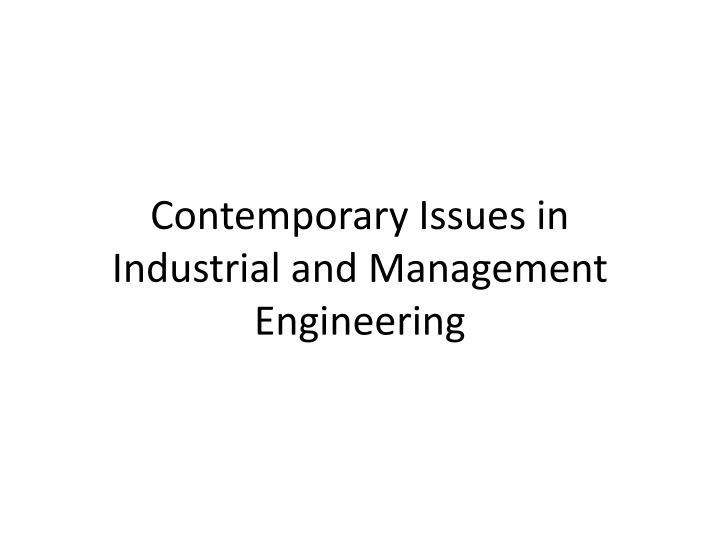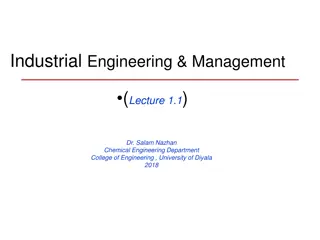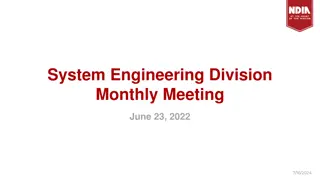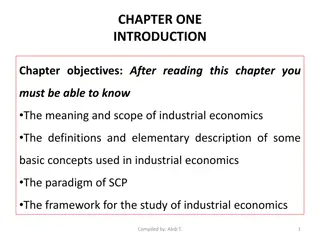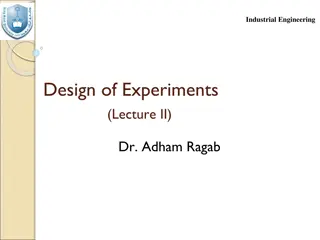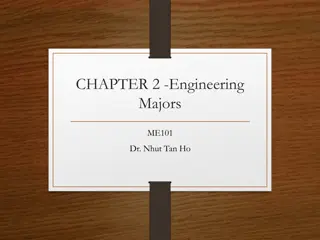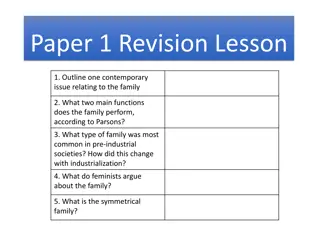Contemporary Issues in Industrial and Management Engineering
Explore the evolution of manufacturing systems from the Industrial Revolution period through key milestones in history to the implementation of Lean Manufacturing principles. The journey encompasses significant advancements in technology, production processes, and management strategies, leading to the optimization of manufacturing operations and the elimination of waste.
Download Presentation

Please find below an Image/Link to download the presentation.
The content on the website is provided AS IS for your information and personal use only. It may not be sold, licensed, or shared on other websites without obtaining consent from the author.If you encounter any issues during the download, it is possible that the publisher has removed the file from their server.
You are allowed to download the files provided on this website for personal or commercial use, subject to the condition that they are used lawfully. All files are the property of their respective owners.
The content on the website is provided AS IS for your information and personal use only. It may not be sold, licensed, or shared on other websites without obtaining consent from the author.
E N D
Presentation Transcript
Contemporary Issues in Industrial and Management Engineering
History of Manufacturing systems Eli Withney (1799) Interchangeable concept in production line From 1799 to late 1890 s each company has their own development in technology by studying: processes Processes arrangements (Facility planning) Chain of processes Work procedures
History of Manufacturing Systems Feredrick W. Taylor Time study and Standardized work Scientific Management Frank Gilbreth Invented Process Charting Lilian Gilbreth Brought Psychology The Ford System(1910): First Comprehensive Manufacturing Strategy People Machines Tooling Products
History of Manufacturing Systems Alfred P. Sloan In GM (1930 s) Toyota Production System (Just in Time) Ohno and Shingo studied: American Production methods Statistical Quality control Ishikawa Deming Joseph Juran Quality Circle Movement: Change the idea about workers and was the fundamental of: Team Development Cellular Manufacturing
History of Manufacturing Systems By reducing setups to minutes and seconds allowed small batches and almost continues flow. All of them occurred between 1949-1975 in 1980 s some other companies like Omrak industries, General Electrics and Kawasaki were achieving success. Womack introduced Lean Manufacturing by a comparative study of Japanese, American and European Assembly lines.
Lean Manufacturing The core Idea is so simple: Relentlessly work on eliminating waste from the manufacturing process What is Waste: Anything and everything that does not add value from the perspective of your customer Lean interrelated concepts: A. Minimizing Waste B. Just in Time Production (JIT) C. Kaizen (Continues Improvement) D. Cell Production
A. How to minimize Seven Deadly Wastes Overproduction Waiting Transport Motion Over processing Inventory Defects
Overproduction Making something before it is truly needed which cause excess inventory Countermeasures for Overproduction Pace The rate of manufacturing matches the rate of demand (Takt Time) production To control how much is manufactured (Kanban) Pull system Reduce Setup Time Smaller batches can be economically manufactured (SMED)
Waiting Time when work-in-process is waiting for the next step in production Countermeasures for Waiting Flow is continues With minimum buffer between steps in production (continues flow) Design Processes To ensure that consistent methods and times are used for each steps of production Standardized work
Transport Unnecessary Movement of raw materials, work-in- process or finished goods Countermeasures for transport Value Stream Mapping Design a linear, sequential flow from raw materials to finished goods Make sure work-in-process is not placed into inventory Continues Flow Theory of Constraints Avoid continual changing of job properties
Motion Unnecessary movement of people Countermeasures for Motion Ensure that work area are logically organized 5S Consider alternative arrangements of equipment that reduce motion Value stream Mapping
Over processing More processing that is needed to produce what the customer requires. Countermeasures for Over processing Compare customer requirements to manufacturing specifications Look for potential simplification to the manufacturing process Kaizen
Inventory Product (raw materials, work-in-process, finished goods) quantities that go beyond supporting the immediate need Countermeasures for Inventory Bring raw materials in only as they are needed Just-In-Time Reduce or eliminate buffers between steps in production Continues Flow Preventing over Production Refer to countermeasures for Over Production
Defects Production that is scrap or requires rework Countermeasures for Defects Design Processes so they are less likely to produce defects Poka-yoke Design process to defect abnormalities so they can be immediately correct Jidoka Root Cause Analysis Look for the single most frequent defect and determine why it occurs Create work instruction that provide a consistent method of manufacturing the part Standardized work
B. Just in Time Pull parts through production based on customer demand instead of pushing parts through production based on projected demand. How does it helps? Highly effective in reducing inventory levels. Improving cash flow and reduces space requirements. Tools which needed: I. Continues Flow II. Heijunka III. Kanban IV. Standard Work V. Takt Time
I- Continues flow Manufacturing Where work in process smoothly flows through production with minimal (or no) buffers between steps of manufacturing process. In the other word no bottleneck (Need bottleneck Analysis) How does it helps? Eliminate many forms of waste (e.g. inventory, waiting time, and transportation)
Bottleneck Analysis Identify Which part of the manufacturing process limits the overall throughput and improve the performance of that part. How does it helps? Improve throughput by strength the weakness link in the manufacturing process.
II- Hejunka ( Level scheduling) A form of production scheduling that purposely manufactures in much smaller batches by sequencing (mixing) product variants within the same process How does it help? Reduces lead time Inventory
III - Kanban Is a method for work management. a method of regulating the flow of goods both within the factory and with outside suppliers and customers. Represent a pull system: Production based on customer demands The 4 core principles of Kanban Start with what you do now Agree to pursue incremental, evolutionary change Respect the current process, roles & responsibilities Encourage Acts of Leadership at All levels
IV Standardized Work Documented procedures for manufacturing that capture best practices. Must be living documents that is easy to change How does it helps? Eliminates waste by consistently applying best practices.
V Takt Time The pace of production (e.g. manufacturing one piece every 34 seconds) that align production with customer demand. Calculated as Planned Production Time / Customer Demand How does it helps? Provides a simple, consistent and intuitive method of pacing production. Is easily extended to provide an efficiency goal for the plant floor (Actual pieces/ Target pieces)
C. Kaizen Kaizen (Continues Improvement) is a strategy where employees at all levels of a company work together proactively to achieve regular, incremental improvements to the manufacturing process. It combines the collective talents within a company to create a powerful engine for improvement.
Dual nature of Keizen As an action Plan: Organizing events focused on improving specific areas within the company which involve teams of employees at all levels. As a philosophy: Building a culture where all employees are actively engaged in suggesting and implementing improvements to the company.
Keizen Events Set goals and provide any necessary background Review the current state and develop a plan for improvement Implement improvement Review and fix what doesn t work Report results and determine any follow-up items
Keizen Philosophy When Keizen is applied as an action plan through a consistent an sustained program of successful Keizen events. Teaches employees to think differently about their works Create long-term value by developing the culture that is needed for truly effective continues development.
D. Cell Production Cell production has the flow production line split into a number of self-contained units. Each team or Workcell is responsible for a significant part of the finished article. Each member of the Workcell only carry out only one very specific task. Team members are skilled at a number of roles, so it means for job rotation
Advantages of Cellular Manufacturing Closness of cell members should improve communication, avoid confusion from misunderstood or non-received message Workers become multi-skilled and more adaptable to the future needs of a business Greate worker motivation, arising from variety of work, team working and more responsibility Quality improvements as each cell has ownership for quality on its area
Disadvantages of Cellular Manufacturing The company has to encourage trust and participation otherwise workers can feel that they are constantly pushed for output with no respect The company may have to invest in new materials handling and ordering systems suitable for cell manufacturing Cell manufacturing may change the sequencing of the machines It is not suitable for some small scale productions Recruitment and training of staff must support this approach of products
